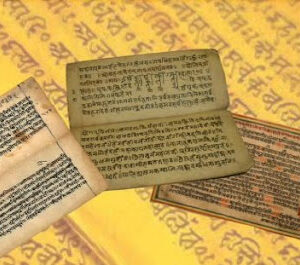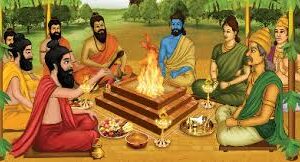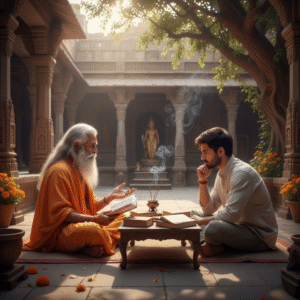Thecosmic order, often referred to asRitain Vedic philosophy, represents the universal law that governs existence, balancing natural and moral principles. In Hinduism, this concept is approached through two distinct lenses:Vedic philosophy, which emphasizes metaphysical inquiry and universal truths, andreligious doctrine, which translates these principles into faith-based practices and moral codes.
This article explores the critical differences between these two perspectives, highlighting how they intersect yet diverge in their approach to understanding the cosmos and human behavior.
Vedic Philosophy: The Intellectual Exploration of Cosmic Order
Vedic philosophy emerges from theVedas, regarded asShruti(divinely revealed knowledge), offering a profound exploration of the metaphysical principles underlying the universe.
Key Features:
- Cosmic Unity: Vedic philosophy focuses on the unity between the individual self (Atman) and the ultimate reality (Brahman).
- Inquiry-Based: Encourages introspection and critical thinking to uncover eternal truths.
- Beyond Rituals: Prioritizes understanding cosmic laws over performing rituals.
- Timeless Principles: Emphasizes universal laws like Rita, which transcend cultural and temporal boundaries.
TheUpanishads, as part of the Vedic corpus, delve into questions about existence, consciousness, and liberation (Moksha), offering insights that continue to inspire philosophical discourse.
Religious Doctrine: Faith and Rituals in Cosmic Harmony
Religious doctrine, on the other hand, translates the abstract principles of Vedic philosophy into actionable guidelines for spiritual practice and moral behavior.
Key Features:
- Faith-Centric: Relies on divine authority and sacred texts like the Puranas and Bhagavad Gita.
- Ritual-Oriented: Emphasizes rituals, prayers, and festivals to maintain cosmic balance and divine connection.
- Moral Framework: Offers clear ethical directives to guide daily life and spiritual growth.
- Community Bonding: Strengthens social cohesion through shared beliefs and practices.
Through practices such asyajnas(sacrifices) andpuja(worship), religious doctrine provides tangible ways for individuals to align with the cosmic order.
Vedic Philosophy vs. Religious Doctrine: A Comparative Table
| Aspect | Vedic Philosophy | Religious Doctrine |
| Nature | Introspective and inquiry-driven. | Faith-based and practice-oriented. |
| Focus | Universal truths and metaphysical principles. | Rituals, morality, and devotion to the divine. |
| Approach | Encourages individual reasoning and self-realization. | Relies on sacred texts and communal traditions. |
| Scope | Timeless and universal principles. | Contextual and adaptable to cultural norms. |
| Example Texts | Upanishads, Rigveda. | Bhagavad Gita, Puranas. |
Interplay Between Vedic Philosophy and Religious Doctrine
Although distinct, Vedic philosophy and religious doctrine are complementary. Philosophy lays the foundation for understanding cosmic laws, while doctrine ensures their practical application through rituals and ethical frameworks. For example:
- Mantra Chanting: A ritual rooted in religious doctrine finds its philosophical basis in Vedic concepts of sound vibrations and their cosmic significance.
- Karma Yoga: Introduced as a philosophical idea in the Bhagavad Gita, it integrates with religious teachings about duty and selflessness.
Relevance in Modern Times
1. Spiritual Depth
Vedic philosophy offers tools for introspection and mindfulness, resonating with contemporary seekers of universal truths.
2. Ethical Living
Religious doctrine provides moral guidance and community support, fostering social cohesion.
3. Holistic Approach
By blending introspection with ritual, individuals can achieve a balanced approach to spiritual growth.
Conclusion: Two Paths, One Goal
Vedic philosophy and religious doctrine, though distinct, work together to illuminate the cosmic order. Philosophy provides the intellectual framework for understanding universal laws, while doctrine translates these principles into meaningful rituals and moral practices.
In modern times, embracing both perspectives allows for a holistic approach to spirituality, where introspection meets devotion, and timeless truths guide practical living. This dual approach ensures that the cosmic order remains relevant, accessible, and inspiring for generations to come.










